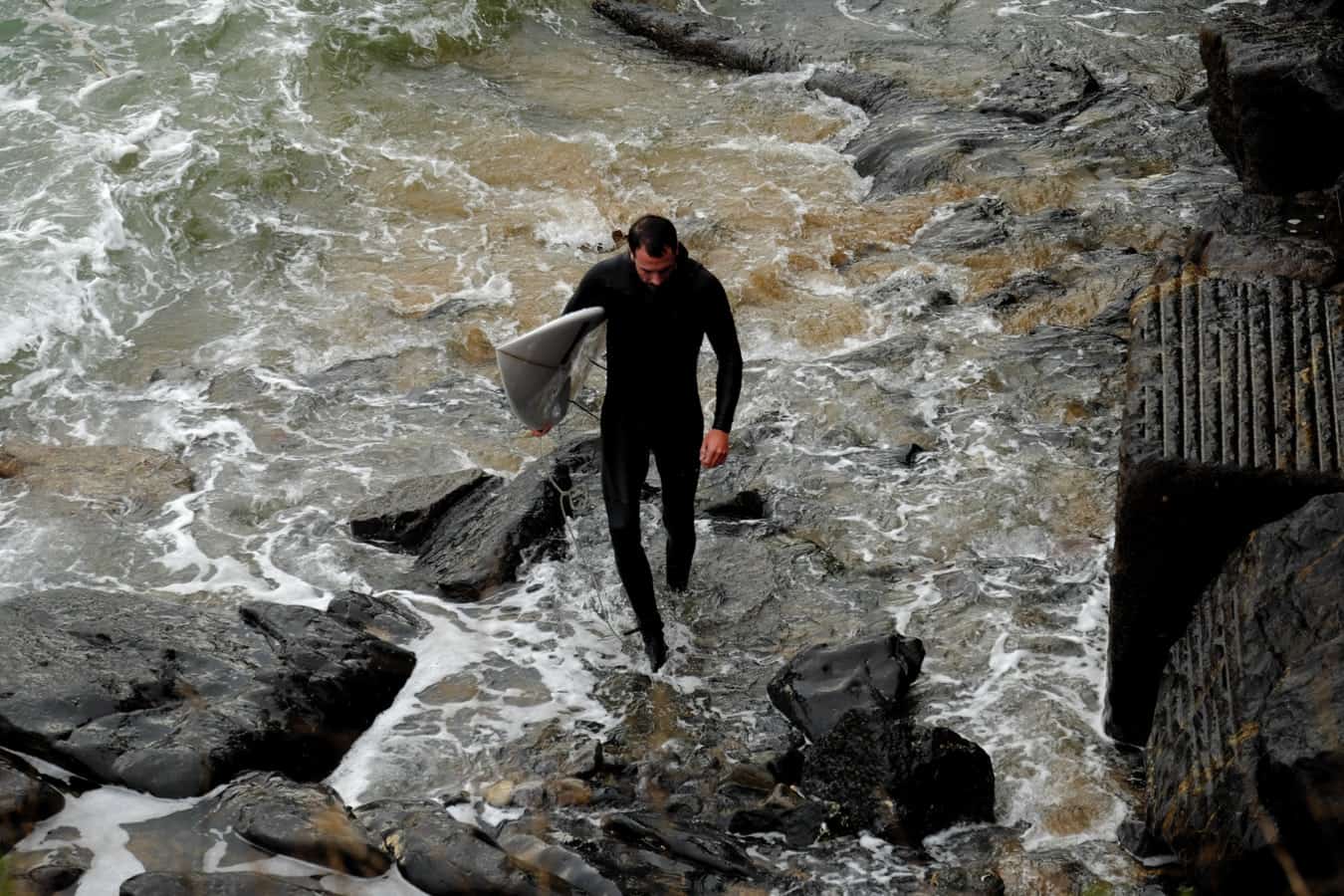It can be challenging to find the right wetsuit. There’s so many options and every brand seems to market different things.
Some are thick, some are thin and they all seem to have different levels of stretch. For such an important piece of surfing gear, you want to make sure you get the right one and that it will last you awhile.
So how do you figure out what the right wetsuit is and is it going to stretch out? The answer depends on what you mean by stretch out. If you’re wondering whether a too small suit will stretch out to fit better over time, the answer is no. If you’re wondering about the shelf life of a wetsuit then yes, over time, heavily stretched areas, like the armpit, thin out from wear.
Wetsuits are made from a synthetic rubber called neoprene. Neoprene is a stretchy insulator-like material.
Inexpensive or low grade neoprene has a bit of stretch while more expensive or high grade neoprene has a lot of stretch. However, this stretch is to make body movements easier and shouldn’t be used to get a smaller wetsuit.
Wetsuits are meant to fit snugly, but the fabric shouldn’t be stretched out or too tight. If it’s hard or uncomfortable to use your full range of motion, or if you feel excessive pulling of fabric, your wetsuit is too tight.
A too tight wetsuit won’t stretch out to fit better over time, it just won’t be able to do its job as effectively and will be very uncomfortable.
On the other hand, even with a well fitted suit, wear and tear will accumulate over time, leading to degraded or stretched out fabric. This is more about the life span of a wetsuit and how long neoprene lasts.
The amount of time it takes to degrade will depend on the suit and how often you use it. Highly stretchy neoprene used to surf multiple times a week will wear out faster than less stretchy neoprene used a few times a month.
How Should a Wetsuit Fit?
Wetsuits are meant to be a second skin so they should feel snug, especially when wearing one dry as it will loosen up considerably in the water.
But what does snug mean? It means that your wetsuit might feel a little weird or slightly uncomfortable at first, but is something you’ll get used to.
If a wetsuit limits your mobility, feels like you can barely breathe, or is highly uncomfortable, it’s too tight. On the other hand, if there’s bunching or gaps in the fit, your wetsuit is too big. It’s kind of like Goldilocks with the porridge, you’re looking for something that’s “just right”.
When trying on wetsuits, pay attention to all the areas of fit. Practice the motions you’ll be doing in the water and see how it feels. Do you have full range and mobility, or is there pulling and over stretching? If there’s excessive pull and stretch, your suit will wear out faster.
Pay attention to how the neck, armholes and footholes feel. Are they flush to the skin, squeezing or are there gaps?
These areas should be flat against your skin without squeezing. Too tight will be uncomfortable and may even restrict circulation. If there are gaps, water will get in through there, defeating the purpose of a wetsuit to stay warm.
Lastly, how do the armpits and groin area fit? Do they bunch up or are there any gaps and pulling? Again, your suit should fit like a second skin.
Gaps or bunching will leak in water while pulling will unnecessarily stretch out the fabric. It may take a little time to find the perfect fit, so don’t give up.
Make sure to try suits from multiple different manufacturers. Brands create their products off different dimensions and models, so every one will fit slightly different.
In addition, different grades of material along with the thickness of the material, will affect fit and how a wetsuit feels. Try them all until you get one just right.
Neoprene Types In Wetsuits
All wetsuits are made of closed cell foam neoprene. This neoprene is a synthetic, stretchy rubber that contains small bubbles that help to keep you warm.
It does so by allowing water in, then trapping it there. Your body heat warms up this water and thus you stay warmer as a result.
All neoprene is not created equal though. Some have better insulating abilities, some have greater stretch and some are more durable than others.
Nylon Lined Neoprene
Traditional wetsuit neoprene is lined with nylon jersey. This jersey helps in getting wetsuits on and off by providing some extra glide.
Nylon also adds an extra layer of protection to the neoprene which helps prevent it from cracking or drying out from the sun. This type is generally the toughest style of neoprene but also provides the least stretch.
Smooth Skin Neoprene
Smooth skin neoprene has a smooth rubbery finish. This finish makes it more wind and water repellent and helps to absorb heat from the sun.
It also holds in more body heat. Often, cold water wetsuits will use smooth skin neoprene over the chest and lower back panels to provide extra warmth to vital areas.
However, this style is less durable and prone to snags and tears, especially while getting on and off, so care is needed.
Air Neoprene
Air neoprene is a special style that sandwiches a layer of perforated neoprene between two other layers. This perforated middle area traps air to insulate the body better.
It allows for the material to be thinner while still providing excellent warmth. It works essentially in the way double pane windows work by creating dead space in the middle.
This style of fabric is usually found in very high end wetsuits.
In addition to these different types of neoprene, the most important classifications are standard stretch or super stretch.
Standard stretch will generally be found in more entry level or inexpensive suits while super stretch is used in all high performance or high end suits.
Greater stretch allows easier movement and more comfortability but it is less durable than standard stretch.
For surfing, wetsuits need to be made with at least 30% super stretch material to allow for the body movements necessary for the activity. 30% is the starting point though and they go all the way up to 100% super stretch neoprene.

Lifespan of a Wetsuit
When it comes to the longevity of your wetsuit, there are a few factors to consider. What style of neoprene is your wetsuit made of, how often do you surf and how do you care for your suit?
All of these make a huge difference in how long your wetsuit can last. Generally the lifespan of a surfing wetsuit is anywhere from one year to several years.
In general, more stretchy and thinner material will wear out and degrade faster than thick or less stretchy material. Although high performance, high stretch suits are more expensive, they usually last a season or two.
More entry level suits made with less stretchy, more durable neoprene can last several years or more. However, with entry level suits, you may be sacrificing comfort and mobility for length of time.
The more you surf, the more use your suit will get, translating into a shorter lifespan. If you’re an everyday or multiple times a week surfer, you’re definitely getting your money’s worth out of your wetsuit.
With lots of use though, a wetsuit will probably last you a year or so. After that time you may notice thinning and overstretching in high movement areas as well as tears or holes.
If you only surf now and then or a few times a month, it will take a much longer time for your wetsuit to reach the same level of wear and tear. In this way your suit could last up to five years.
The most important aspect of wetsuit longevity though is care. How you care for your wetsuit will make a huge difference in how long it lasts for.
With good care, even high performance, heavily used wetsuits can last you a couple years. Which makes a difference when investing in quality gear.
To take proper care of your wetsuit, be sure to rinse it with cool fresh water both inside and out after every surf. Wash it by hand with mild detergent.
Keep it out of the sun and away from heat as this can dry out and crack your fabric. Don’t hang it up through the shoulders to avoid stretching them out. And lastly, store it somewhere cool and dry.
Related Questions
What Do You Wear Under a Wetsuit?
What you wear under a wetsuit is up to you.
It’s common for people to wear board shorts or swimsuits under their wetsuits. Some people go naked under their wetsuits and others wear a rashguard underneath for extra protection.
How Do You Put On a Wetsuit?
Since wetsuits are made to fit tight, they can be hard to get on and off, especially when dry. There are tricks and tips to putting on wetsuits but the biggest key is to start from the bottom up.
Bunch up your suit and place your feet all the way through the foot hole, then roll the suit up your leg. Like putting on pantyhose. Do the same through the arms.
It can still be tricky, but putting your suit on this way will help keep you from getting stuck.


